Psychodynamic Approach Pdf Download
Today in this article we will give you full info related to Psychodynamic Approach Pdf Download, this will help you understand in a different way at the end of this article you will get a Summary too, and that Summary you can use in your Upcoming Competition Essay or in Exams.
Assumptions of the Approach
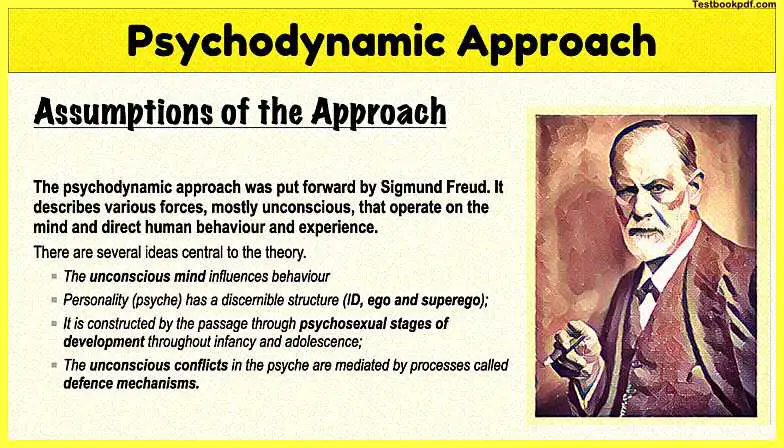
The psychodynamic approach was put forward by Sigmund Freud and it’s an approach that describes various forces most of which are unconscious that operate on the mind and direct human behavior and experiences the approach revolves around three or four central ideas the concept of the unconscious the idea that personality has a discernible structure and comes about through progression through the psychosexual stages of development and that unconscious conflicts brought about by this whole process are mediated by defense mechanisms.
The Role of the Unconscious
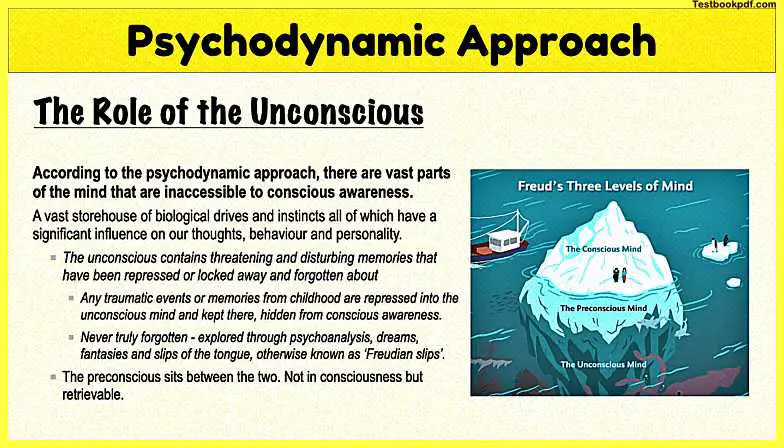
So at the heart of the psychodynamic approach is the concept of the unconscious freud suggested that the part of our mind that we know about and are aware of the conscious mind is only the tip of the iceberg and that in fact the majority of our mind is made up of the unconscious which he described as a vast storehouse of biological drives and instincts all of which have a significant influence on our thoughts our behavior and our personality he also said that the unconscious contains threatening and disturbing memories that have been repressed or locked away and forgotten about and that these memories can be accessed during dreams or through slips of the tongue just bubbling under the surface of our conscious mind is the pre-conscious which contains thoughts and memories which aren’t currently in conscious awareness but we can access them if we desire to do so so that is the first part and having a clear understanding of what the unconscious is and also kind of understanding that a lot of what goes on in the psychodynamic approach actually does occur in the unconscious mind is going to be a really really key factor to kind of fully understanding this approach.
The Structure of Personality
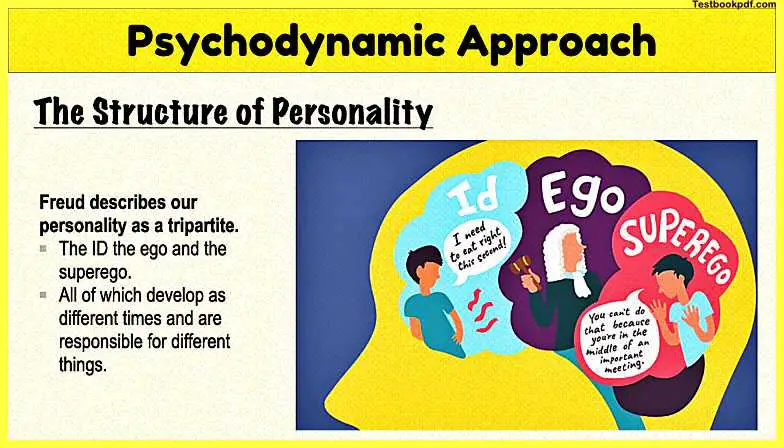
Now let’s have a look at the structure of personality freud describes our personality as tripartite which means that it consists of three parts and those parts are the id the ego and the superego all of which develop at different times and are responsible for different things so the id is the primitive part of our personality it’s present from birth and it’s described as a mass of unconscious drives and instincts and urges it operates on what’s known as the pleasure principle it wants what it wants when it wants it and it’s completely selfish and demands instant gratification of its needs imagine a baby screaming at you because it wants something you can’t reason with it you can’t tell it to be quiet or anything like that you just have to satisfy what it wants and then it quiets down again that’s effectively what the id is the second part to develop at around the age of two is the ego now the ego works on the reality principle and it strives to satisfy the id’s desires in a realistic and socially appropriate way weighs up the costs and benefits of an action before deciding to act upon or abandon the impulse it also acts as a mediator between the other two parts of personality attempting to reduce the conflict between the demands of the id and the demands of the superego and it does that by employing what’s known as defense mechanisms which we’ll have a look at in a little while the final part of personality is the superego
Now the superego was formed at the end of the phallic stage of psychosexual development around the age of five it’s our internalized sense of right and wrong and it’s based on the morality principle it represents the moral standards of our same-sex parent and it punishes the ego through feelings of guilt but also rewards the ego with pride when it does something correct effectively the superego tries to perfect and civilize our behavior and it works really really hard to suppress all of the unacceptable urges of the id and it tries its best to make the ego act upon some idealistic standards rather than upon realistic principles.

Now as I said earlier Freud suggests that the id and the superego are in constant conflict with each other and just by looking at what’s on the screen now and seeing what actually the id and the superego stand for and what they’re involved in it’s no surprise that they are in constant conflict with each other the id has these primal urges always wanting and crazing for stuff some of which can be disturbing or even destructive whether it’s food sleep sex violence or anything and the superegos constant need to hold us to some kind of higher standard some kind of idealistic standard and then it punishes us if we don’t uphold that standard so it falls to the ego to mediate between the two other elements
Defense Mechanism
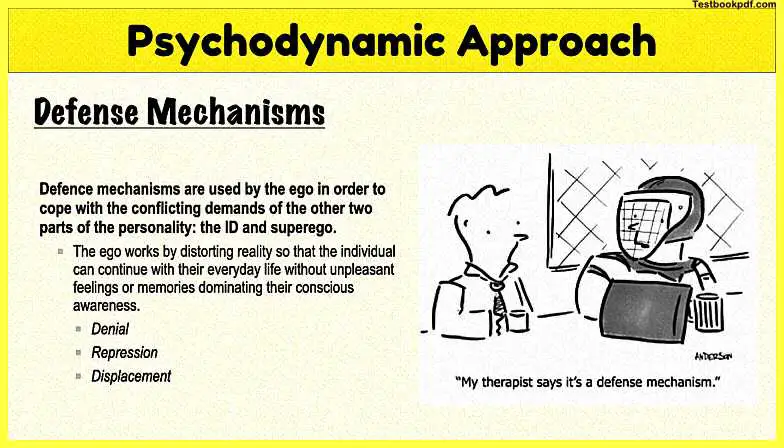
And the ego does that through defense mechanisms now these defense mechanisms are unconscious and they stop the ego from being overwhelmed by threats or by trauma or by the demands of the id or the superego now unfortunately they generally involve some kind of distortion of reality and they’re generally regarded as psychologically unhealthy if they’re used in the long term effectively it’s a little bit like putting a pretty picture over a crack in the wall it’s going to look nice and do the job in the short term but if you leave it there for too long your house is going to fall down and that’s kind of the same deal with defense mechanisms now some defense mechanisms that people use fairly regularly are things like denial repression and displacement denial being the refusal to acknowledge some aspect of reality repression is forcing a distressing memory out of your conscious mind and refusing to deal with it and displacement is transferring feelings from a true source of distressing emotion onto a substitute target.
The Psychosexual Stages
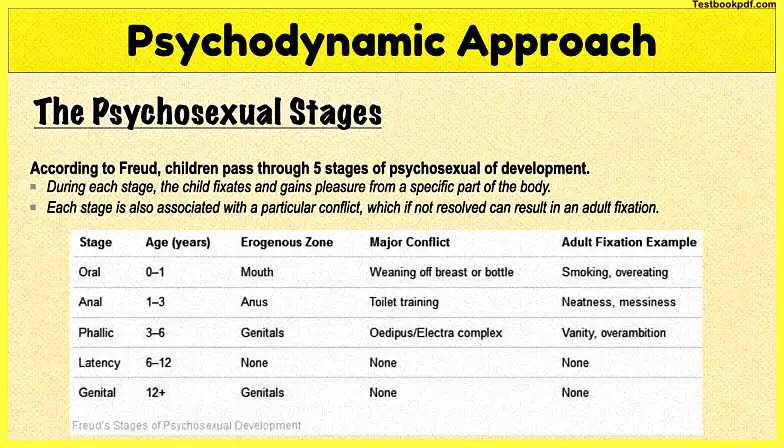
So as a final element of the psychodynamic approach we have the psychosexual stages now according to freud our personality develops as we progress through five stages of psychosexual development and these are five stages that children must pass through in order to be psychologically healthy and well adjusted in adult life each stage is marked by a different conflict that the child must resolve in order to progress successfully to the next stage and any conflict that remains unresolved leads to a fixation where the child becomes stuck and then potentially carry certain behavior and conflicts associated with that stage through to adult life you can see the stages there there is oral anal phallic latency and genital and you can see the conflict of each stage as well so in the oral stage the conflict is weaning off the breast or off bottle now effectively if you’re going to remove the word conflict it is effectively a developmental milestone the milestone is weaning off the breast and going over to food or proper food and you can see the adult fixation if the child doesn’t master this conflict or resolve this conflict within the given time frame then it can go on to things like smoking overeating nail biting and that is what’s known as an oral fixation.
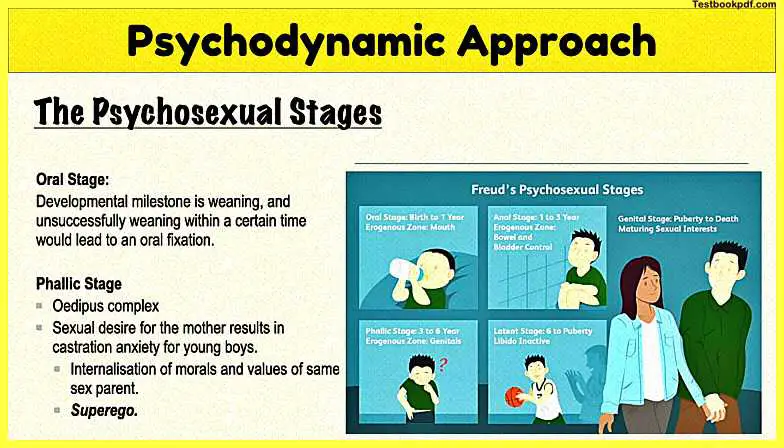
Now some of these stages and conflicts are fairly self-explanatory and they are ones that you could just about get your head around, for example, in the oral stage like we just said the developmental milestone is weaning, and unsuccessfully weaning within a certain time would potentially lead to an oral fixation or if you’re going to take the anal stage the developmental milestone is potty training and if you don’t potty train within the given time frame it can lead to people being overly messy or overly neat when they’re adults and that’s known as being anally retentive okay now there are other stages that are slightly more bizarre.
For example, in the phallic stage which is the third stage, Freud suggests that boys develop incestuous feelings for their mothers and they also develop a murderous hatred for their fathers who they consider to be rivals in their love for the mother and that’s known as the Oedipus complex which makes up a really really important part of the psychosexual stages of development now during this time the boys experience something called castration anxiety by their fathers which effectively means the boys are scared that that is going to realize how they feel about mum and then that is going to come and castrate them.
So as a result of that anxiety the boys repressed their feelings for their mothers banishing them into the depths of their unconscious minds which technically means that the feelings are still in there somewhere but let’s not think about that and then as a result of that they start to identify with their fathers they internalize the gender roles they internalize the father’s values and morals which then ultimately leads to the resolution of the Oedipus complex and also ultimately leads to the development of the superego.
So that is the end of the outline and it’s probably a good idea to just let that sink in for a sec because there’s quite a lot there and some of it is fairly bizarre and you might just need to take a little bit of time to just kind of get your head around it on that note there is a lot of information and a lot of individual components to the psychodynamic approach it’s fairly standard because this is now considered year two material and so it’s fairly normal to get quite a lot of information because part of the trick is now going to be to actually whittle down everything that you’ve learned into stuff that’s important when it comes to writing an outline the good news is you won’t need to include all of this when you do write an outline however it is still going to be really important for you to understand all of the processes that underpin this approach because they can come up in all kinds of questions whether they are application questions essay questions short answer questions you name it it can all be tested in some form or another which you will see at the end of this Paragraph.
Outline the Psychodynamic Approach
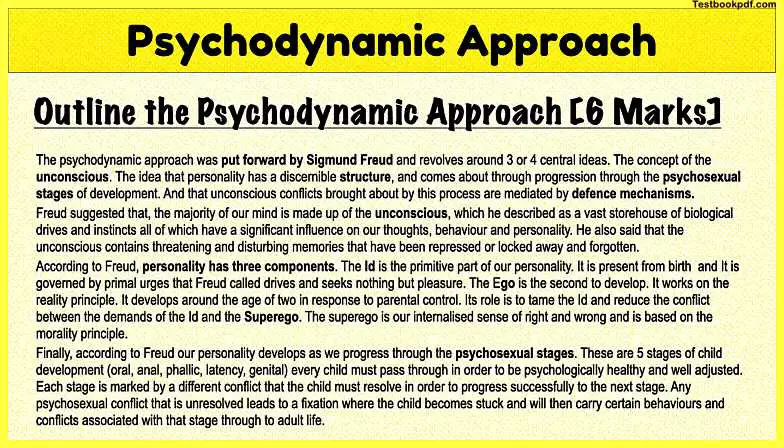
So just to finish off then I’m going to show you what a six-mark answer could look like for this approach bear in mind there is a lot of information and that automatically means that the outline is going to be quite long
So this is how I would do it personally I would write a little bit of an introduction because as I’m sure you’re aware from previous articles I’m fairly fond of introductory paragraphs because they just set the scene it’s also a nice opportunity to get all of the keywords into one paragraph so that the examiner knows that you know them
I would then talk about the unconscious in less detail as you heard it previously but in enough detail for the examiner to know that you know it
Then comes the personality and the fact that it has three components again you can see there isn’t very much detail on each of them but there is a little bit and then finally I would talk about the psychosexual stages now as you can see just by looking at it I have given a little bit more detail to the psychosexual stages but that’s fine it doesn’t really matter it’s just about getting the right amount of depth and breadth.
Now what I have done here, however, is I have left out any kind of detail on the defense mechanisms the only thing that I have done is in my first paragraph I’ve said that unconscious conflicts are mediated by defense mechanisms but I haven’t talked about them any further than that I don’t need to I’ve got enough detail throughout and talking about the defense mechanisms aren’t going to add anything to my outline.
Explanatory Power
We’ll start with the strength of the psychodynamic approach and that is that it has a great ability to explain human behavior now although the psychodynamic approach is generally considered fairly controversial and bizarre at times it has had a huge influence on western psychology and kind of western contemporary thought and it was a key force in psychology for the first half of the 20th century alongside behaviorism it’s been used to explain a wide range of disorders conditions phenomena for example personality development abnormal behavior moral development gender identity there’s loads and loads of stuff that the psychodynamic approach has got involved with it also draws attention to the connection between childhood experiences such as our relationships to our parents and our later development which is something that at the time theories had never done before so that was really really important for the psychodynamic approach so all of that suggests that the psychodynamic approach has had a positive impact on psychology and also on things like literature and art and other human endeavors.
Practical Application
Moving on another strength of the psychodynamic approach is that it has practical application okay so the psychodynamic approach introduced the idea of psychotherapy and it brought to the world a new form of therapy called psychoanalysis which was one of the first attempts to treat mental disorders psychologically rather than physically which is how it had been attempted to be treated up until that point it’s also the forerunner to a lot of modern day talking therapies like counseling that have since been established and so it really did lay the foundations for the types of psychotherapy that are seen commonly these days although to be fair psychoanalysis is still used today and it is still something that is commonly sought out by people who want some psychotherapy it uses a range of techniques that are designed to access the unconscious such as dream analysis and psychoanalysis generally claims to be able to help clients by bringing their repressed emotions into their conscious mind so that they can be dealt with so this emergence of a new form of therapy psychoanalysis shows the value in the psychodynamic approach because it did create a new approach to treatment and it did create a new way of helping people.
The counterpoint to Practical Application
However that being said there is a counterpoint to this practical application and that is that as much as Freudian therapists have claimed success with many clients with neuroses mild neuroses psychoanalysis is generally regarded as inappropriate or even harmful for people who experience more serious mental disorders, for example, people with schizophrenia often experience things like paranoia and delusional thinking which means that those people with schizophrenia have lost their grip on reality and that means that they generally won’t be able to articulate their thoughts in the way that’s very often required by psychoanalysis so that suggests that Freudian therapy and theory may not be applicable to all mental disorders but only those that have more of a mild condition.
Limitation – Falsifiability
And then as a final limitation we have the issue of falsifiability now one problem of the psychodynamic approach is that many of its core concepts are simply very very abstract and then not testable so this kind of brings us to the work of carl popper who argued that the approach doesn’t meet the scientific criteria of falsification now falsification means that it’s not open to empirical testing and it’s not possible to be proved wrong and that’s a really big thing because all scientific theories and disciplines have to be open to the possibility of being disproved they have to be able to be empirically tested and that’s just not possible with the psychodynamic approach because concepts like the id and the ego and the oedipus complex and defense mechanisms they all happen on an unconscious level which make them impossible to test because how are you supposed to test something that’s unconscious you’re not even aware that it’s there or that you’re using it and so testing it is really really difficult also his ideas are based on single individuals such as people like little hands or anna oh and feel free to google who those people were but effectively freud used case studies which makes it really difficult for him to be able to make universal claims about human behavior because the reality is his theory is based on the study of a couple of unique individuals rather than large scale samples so according to popper that makes the psychodynamic approach more of a pseudoscience which effectively means a fake science rather than a real science and that is a limitation of this particular approach.
Evaluation Points in Brief
Okay so just as a quick recap here were the evaluation points in brief you’ve got your practical application with your counterpoint your falsifiability and your explanatory power now just to be clear i’ve changed the order um on this slide compared to how i presented them that’s simply because this is the order that i personally would learn them in obviously it goes without saying ideally you would learn all of these points in order to try and push up to a top band mark in an essay however if you don’t feel like you can learn all of them then this is the order that i would prioritize them so i’d start with the practical application and the counterpoint simply because it is a nice chunky evaluation point if you use both of those together and that will definitely get you marks the falsifiability one is another really nice limitation to have because it simply covers everything in the psychodynamic approach and it is something that you could get asked about in research methods as well so there’s a nice link there to another topic the explanatory power evaluation point is also a nice evaluation point and it is also a useful evaluation point however it is the one that i would leave out if you are likely to struggle to remember all of them so just to finish off then.
In an Exam
Let’s have a look at how this has come up in an exam so far just so that you know what could come your way so just to start us off we’ve got a couple of standard bread and butter short answer questions that describe the structure of personality according to the psychodynamic approach is obviously referring to the id the ego and the superego briefly evaluate defense mechanisms as a way of explaining human behavior and experience okay that would be a nice little opportunity to use your falsification evaluation point because defense mechanisms happen unconsciously outline one limitation of the psychodynamic approach again you’ve got two to choose from you can use your falsification evaluation point or you could reword the counterpoint a little bit and use that instead it all kind of depends on how many marks it’s worth and these three questions could come up for somewhere between two and six marks potentially.
So describe the structure of personality is likely to be four or six the one limitation of the psychodynamic approach could be anywhere between two and four and briefly evaluating defense mechanisms could also be anywhere between two and four okay so that’s kind of one way in which you could get it obviously you could get essays as well that goes without saying and I’m not going to put an essay title up here for you um because everyone kind of knows what an essay title looks like um you’ve also got some application bits.
So obviously part a in this one is just outline a psychodynamic explanation for the development of the superego so that’s going to want you to talk about things like the resolution of the oedipus complex and the internalization of the morals and values of your same-sex parent which then ultimately leads to the development of the superego you’ve then got this application section that follows on directly from it so again you’d be looking at talking about how the superego kind of wants us to follow this ideal moralistic standard and that it would be making us feel guilty for wanting to steal the t-shirt and so on and so on okay and then a final one is this one identify and explain the defense mechanism that jed was displaying okay so he’s displaying displacement because he is taking out his angle he’s transferring his feelings from the true source which is obviously the teacher or the fact that he got a detention and he’s transferring those feelings from that source onto a substitute target which is the locker now this question could come up as a two marker but it’s more likely to come up as a three or a four marker because as the question says it wants you to identify it which will be one mark and then explaining the defense mechanism could be anywhere between two and three marks so you’re looking at a three or four marker in total for this question.
Read also:
Humanistic Approach Psychology Pdf



